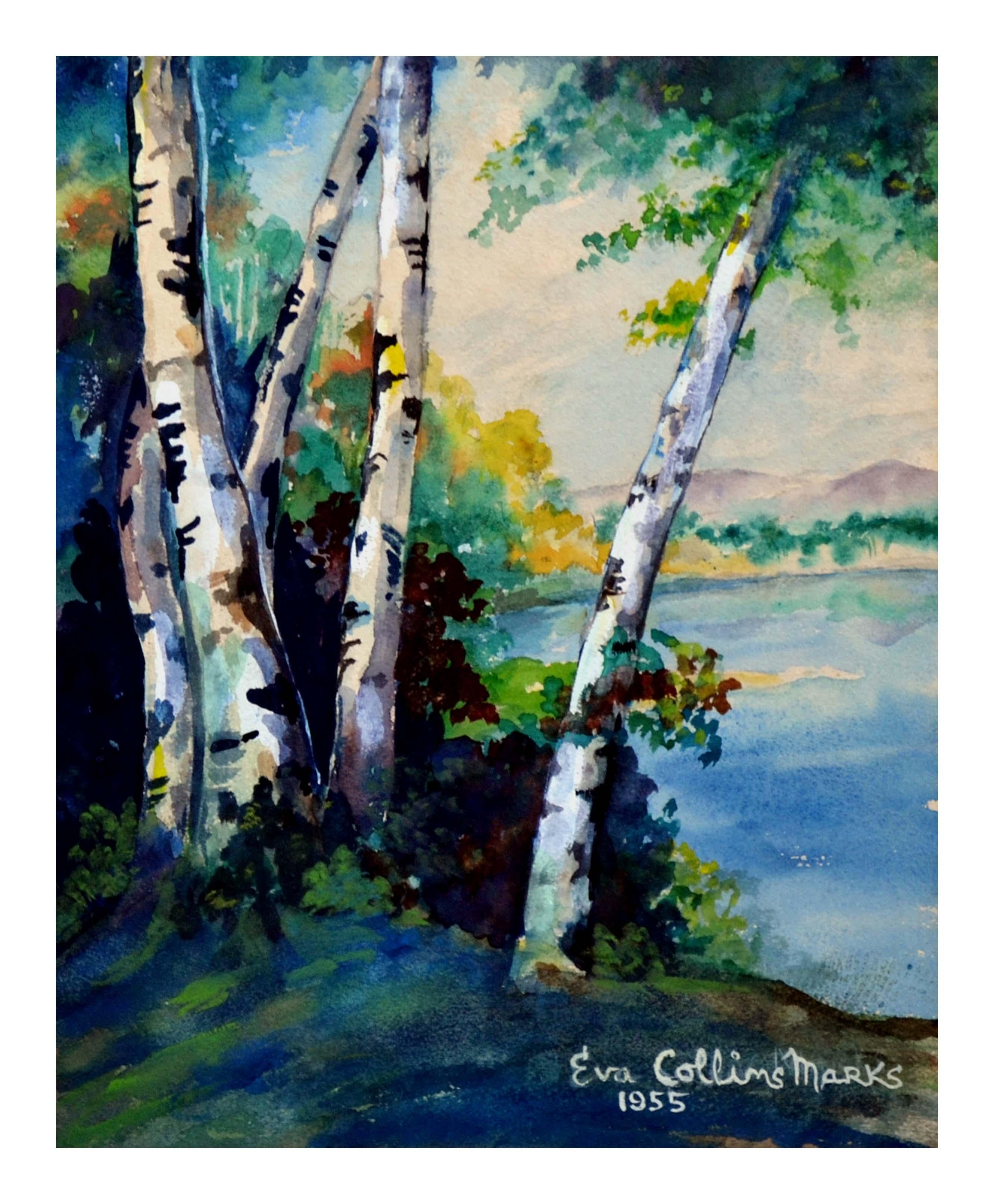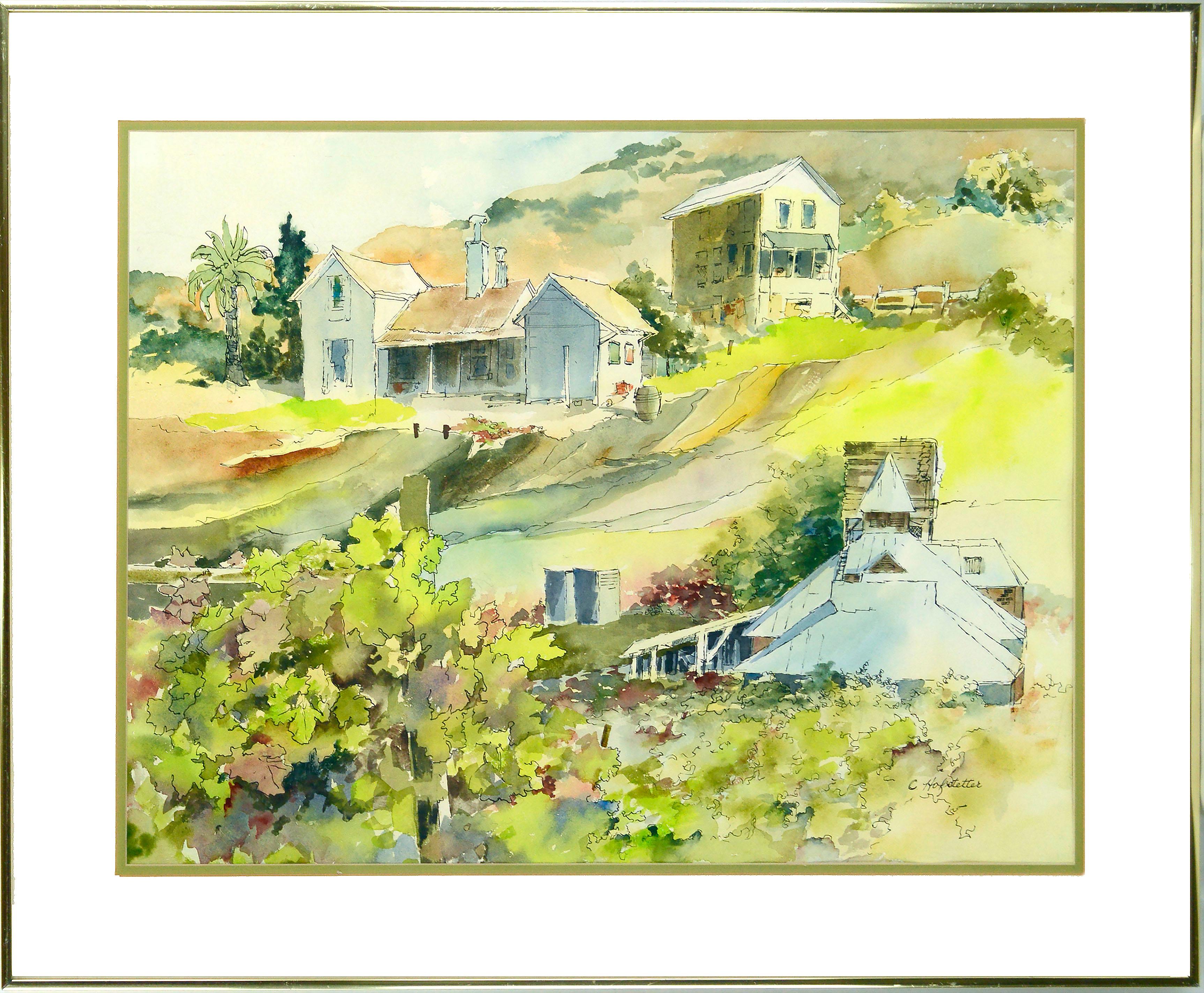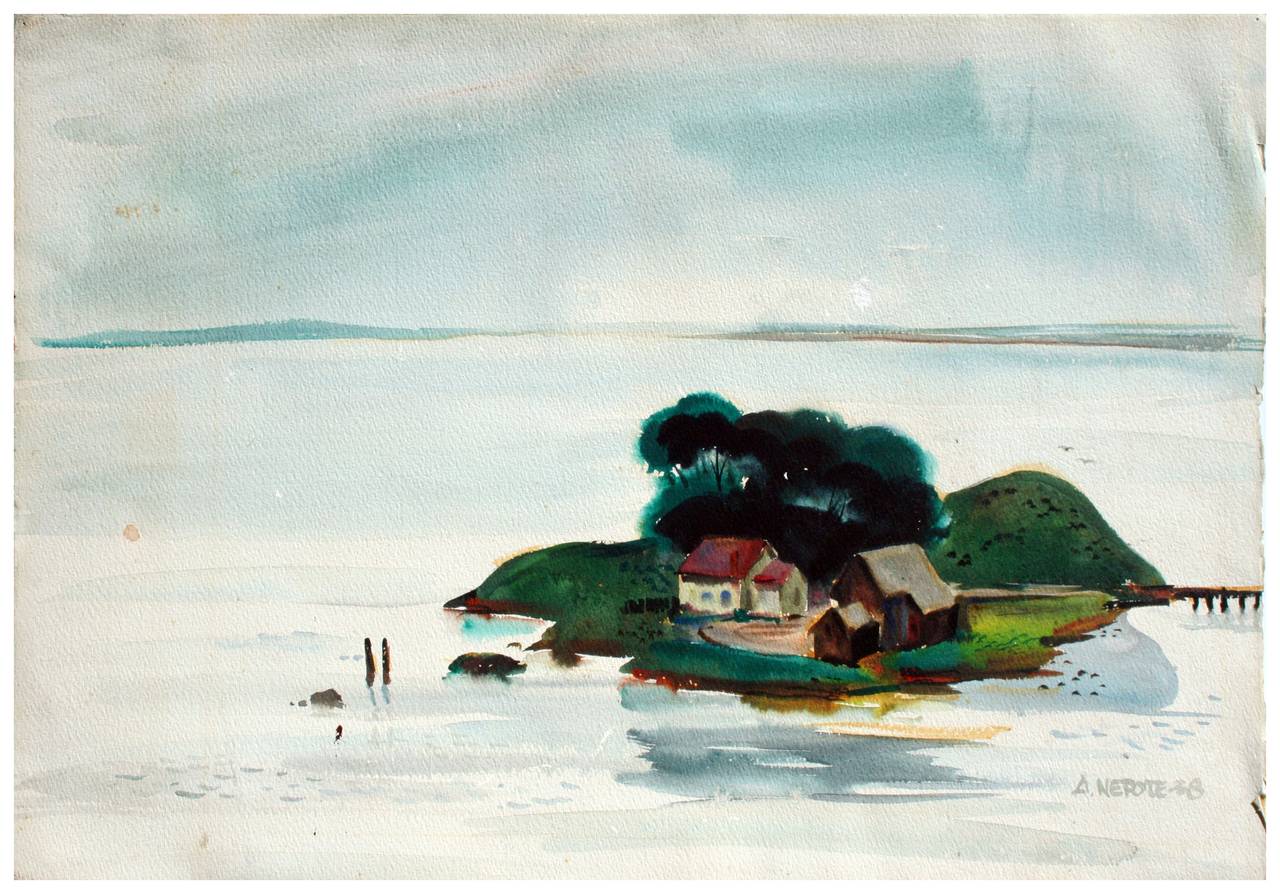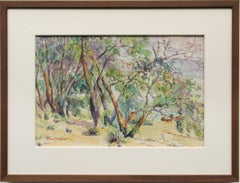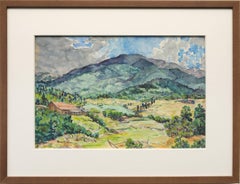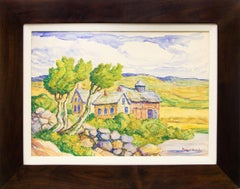
Kansas Farm (Prairie, River, Farm House and Barn)
View Similar Items
Want more images or videos?
Request additional images or videos from the seller
1 of 10
Birger SandzenKansas Farm (Prairie, River, Farm House and Barn)1940
1940
About the Item
- Creator:Birger Sandzen (1871-1954, American)
- Creation Year:1940
- Dimensions:Height: 22.5 in (57.15 cm)Width: 29.75 in (75.57 cm)Depth: 1 in (2.54 cm)
- Medium:
- Movement & Style:
- Period:
- Condition:very good to excellent condition with no notable damage, paint loss, tears, punctures, etc.
- Gallery Location:Denver, CO
- Reference Number:Seller: DCG-213271stDibs: LU2731747933
About the Seller
5.0
Platinum Seller
These expertly vetted sellers are 1stDibs' most experienced sellers and are rated highest by our customers.
Established in 1979
1stDibs seller since 2013
264 sales on 1stDibs
Typical response time: 5 hours
More From This SellerView All
- Colorado Ranch Summer Landscape Painting, 1940s Landscape WatercolorBy Irene D. FowlerLocated in Denver, COOriginal western landscape painting of trees near a ranch in Colorado by Irene Fowler, one of Colorado's preeminent women artists of the 20th century. Presented in a custom frame, outer dimensions measure 17 ½ x 23 ½ x 1 ½ inches. Image size is 11 ½ x 17 ¼ inches. Painting is clean and in very good vintage condition - please contact us for a detailed condition report. Expedited and international shipping is available - please contact us for a quote. About the Artist: An important figure in the development of Denver as an artistic city, Irene Fowler was a public school teacher and founding member of the Denver Artist’s Guild (now the Colorado Artist’s Guild) in addition to being a prolific artist. She exhibited in Denver at the Schlier Gallery (where she had a solo exhibition), at the Chappell House, the University Club...Category
Mid-20th Century American Impressionist Landscape Drawings and Watercolors
MaterialsWatercolor
- Mountain Ranch, Modern Summer Colorado Mountain Landscape, Watercolor PaintingBy Irene D. FowlerLocated in Denver, COOriginal signed watercolor painting of a ranch in the Colorado mountains in springtime or summer coloring of green, blue, yellow, white and brown by Denver artist, Irene Fowler. Presented in a custom frame with all archival materials, outer dimensions measure 17 ½ x 23 ½ x 1 ½ inches. Image size is 12 x 18 inches. About the Artist: An important figure in the development of Denver as an artistic city, Irene Fowler was a public school teacher and founding member of the Denver Artist’s Guild (now the Colorado Artist’s Guild) in addition to being a prolific artist. She exhibited in Denver at the Schlier Gallery (where she had a solo exhibition), at the Chappell House, the University Club, and the Broadmoor Art Gallery in Colorado Springs. In 1950-1952 she served as president of the Denver Artist’s Guild. Fowler painted in oil or watercolor and her paintings were almost exclusively done en plein air. Her landscapes of Colorado...Category
Mid-20th Century American Impressionist Landscape Drawings and Watercolors
MaterialsWatercolor
- Sangre de Cristo Mountains, Southern Colorado Watercolor Landscape PaintingBy Alfred WandsLocated in Denver, COVintage original modernist watercolor painting of the Sangre de Cristo Mountain range in Colorado by Alfred Wands (1904-1998). A farm in th...Category
20th Century American Impressionist Landscape Paintings
MaterialsWatercolor
$2,720 Sale Price20% Off - California Coast Landscape Marine Painting, Watercolor Painting Rocks, WavesBy Charles Partridge AdamsLocated in Denver, COCalifornia coastal painting by early 20th century artist, Charles Partridge Adams circa 1925. Watercolor on paper, not signed, attributed ...Category
1920s American Impressionist Landscape Paintings
MaterialsWatercolor
- Silver Plume, Colorado, Framed Colorado Mountain Landscape Oil Pastel DrawingBy Elsie Haddon HaynesLocated in Denver, COSilver Plume, Colorado - near Georgetown, mountain landscape with fall colors, Aspen and Pine trees, river, houses and mountains by early 20th century Co...Category
1930s American Impressionist Landscape Drawings and Watercolors
MaterialsOil Pastel, Pastel
- Colorado Mountain Winter Landscape Watercolor Painting, Blue, Orange, PurpleLocated in Denver, COColorado mountain landscape watercolor painting signed by artist Rita Derjue (1934-2020) depicts Cabins in the Snow in bright tones of blue, yellow, green and red/brown. Signed by the artist in the lower right corner. Presented in a custom frame with archival materials, outer dimensions measure 24 ⅛ x 31 ½ x 1 ¼ inches. Image sight size is 14 ½ x 21 ½ inches. About the Artist: Born Rhode Island, 1934 Artist, educator, mentor and community activist, Derjue is the daughter of European parents whose family members had previous connections with New York and New England. Her drawing talent as a youngster in Rhode Island caught the attention of family friend Johann Groen, a Dutch-born painter and photographer, who encouraged her to spend time touring and studying in Europe to further her art education. In 1956 she earned her Bachelor of Fine Arts degree at the Rhode Island School of Design that emphasized the fundamentals of drawing and design. Her most memorable teacher was Richard Hamilton, whose work was influenced by German Expressionist Max Beckmann and the jazz greats. Her studies from nature and Cubist compositions done at that time reflect her interest in early twentieth-century European modernist painting. She had the opportunity to experience it firsthand during a year of post-graduate work at the renowned Akademie den Bildenden Kunste in Munich, Germany, in 1956-57. She studied with Ernest Geitlinger (1895-1972) whom the Nazi government classified as a “degenerate” artist in the 1930s, preventing him from exhibiting in Germany. After World War II he was one of the co-founders of the Munich artists’ association, Neue Gruppe, in 1946 and played an important role in abstract painting. While studying with him in Munich she produced a number of canvases in a referential abstract style. She also became acquainted with the Blaue Reiter group that flourished in the early twentieth century and whose expressionism strongly influenced her color palette and painting style. She particularly admired the work of Blaue Reiter co-founder and Wassily Kandinsky’s long-time partner, Gabriele Münter, whose work she studied at the Lenbachhaus in Munich and at the Gabriele Münter Haus and the Schlossmuseum in Murnau south of Munich. Derjue’s immersion in German Expressionism imparted a bold, simplified style to her work. In 1958 with a friend from Munich she went to Mexico for a year, studying with artist Frank Gonzalez in his studio in San Angel, Mexico City, and with Canadian artist, Toni Onley, in San Miguel de Allende. Onley had recently won a scholarship to the Instituto Allende to study mural and fresco painting with David Siqueiros, one of the three greats of Mexican muralism. At the Instituto Onley began painting large black-and-white canvases in an abstract impressionistic style which he imparted to Derjue, who thereafter began exploring color and space in the dimensions of her own large compositions. With writer Gregory Strong, he subsequently published Onley’s Arctic and his autobiography, The Tony Onley Story. After returning to the United States, she worked as a graphic designer for Little, Brown and Company, publishers in Boston. She began dating her future husband, Carle Zimmerman, whom she met earlier in Europe and whom she married in 1960. Joining him at Cornell University where he was completing his Ph.D degree, she earned her Master of Arts degree at the same institution and participated in group shows at the Herbert F. Johnson Museum and the Munson-Williams-Proctor Arts Institute in upstate New York. In 1963 Derjue and her husband relocated to Littleton, Colorado, where he spent his entire career, first as a research engineer and later as a departmental manager for the Marathon Oil...Category
20th Century American Modern Landscape Paintings
MaterialsWatercolor, Archival Paper
$2,200 Sale Price20% Off
You May Also Like
- "Train Station, " Max Kuehne, Industrial City Scene, American ImpressionismBy Max KuehneLocated in New York, NYMax Kuehne (1880 - 1968) Train Station, circa 1910 Watercolor on paper 8 1/4 x 10 1/4 inches Signed lower right Provenance: Private Collection, Illinois Max Kuehne was born in Halle, Germany on November 7, 1880. During his adolescence the family immigrated to America and settled in Flushing, New York. As a young man, Max was active in rowing events, bicycle racing, swimming and sailing. After experimenting with various occupations, Kuehne decided to study art, which led him to William Merritt Chase's famous school in New York; he was trained by Chase himself, then by Kenneth Hayes Miller. Chase was at the peak of his career, and his portraits were especially in demand. Kuehne would have profited from Chase's invaluable lessons in technique, as well as his inspirational personality. Miller, only four years older than Kuehne, was another of the many artists to benefit from Chase's teachings. Even though Miller still would have been under the spell of Chase upon Kuehne's arrival, he was already experimenting with an aestheticism that went beyond Chase's realism and virtuosity of the brush. Later Miller developed a style dependent upon volumetric figures that recall Italian Renaissance prototypes. Kuehne moved from Miller to Robert Henri in 1909. Rockwell Kent, who also studied under Chase, Miller, and Henri, expressed what he felt were their respective contributions: "As Chase had taught us to use our eyes, and Henri to enlist our hearts, Miller called on us to use our heads." (Rockwell Kent, It's Me O Lord: The Autobiography of Rockwell Kent. New York: Dodd, Mead and Co., 1955, p. 83). Henri prompted Kuehne to search out the unvarnished realities of urban living; a notable portion of Henri's stylistic formula was incorporated into his work. Having received such a thorough foundation in art, Kuehne spent a year in Europe's major art museums to study techniques of the old masters. His son Richard named Ernest Lawson as one of Max Kuehne's European traveling companions. In 1911 Kuehne moved to New York where he maintained a studio and painted everyday scenes around him, using the rather Manet-like, dark palette of Henri. A trip to Gloucester during the following summer engendered a brighter palette. In the words of Gallatin (1924, p. 60), during that summer Kuehne "executed some of his most successful pictures, paintings full of sunlight . . . revealing the fact that he was becoming a colorist of considerable distinction." Kuehne was away in England the year of the Armory Show (1913), where he worked on powerful, painterly seascapes on the rocky shores of Cornwall. Possibly inspired by Henri - who had discovered Madrid in 1900 then took classes there in 1906, 1908 and 1912 - Kuehne visited Spain in 1914; in all, he would spend three years there, maintaining a studio in Granada. He developed his own impressionism and a greater simplicity while in Spain, under the influence of the brilliant Mediterranean light. George Bellows convinced Kuehne to spend the summer of 1919 in Rockport, Maine (near Camden). The influence of Bellows was more than casual; he would have intensified Kuehne's commitment to paint life "in the raw" around him. After another brief trip to Spain in 1920, Kuehne went to the other Rockport (Cape Ann, Massachusetts) where he was accepted as a member of the vigorous art colony, spearheaded by Aldro T. Hibbard. Rockport's picturesque ambiance fulfilled the needs of an artist-sailor: as a writer in the Gloucester Daily Times explained, "Max Kuehne came to Rockport to paint, but he stayed to sail." The 1920s was a boom decade for Cape Ann, as it was for the rest of the nation. Kuehne's studio in Rockport was formerly occupied by Jonas Lie. Kuehne spent the summer of 1923 in Paris, where in July, André Breton started a brawl as the curtain went up on a play by his rival Tristan Tzara; the event signified the demise of the Dada movement. Kuehne could not relate to this avant-garde art but was apparently influenced by more traditional painters — the Fauves, Nabis, and painters such as Bonnard. Gallatin perceived a looser handling and more brilliant color in the pictures Kuehne brought back to the States in the fall. In 1926, Kuehne won the First Honorable Mention at the Carnegie Institute, and he re-exhibited there, for example, in 1937 (Before the Wind). Besides painting, Kuehne did sculpture, decorative screens, and furniture work with carved and gilded molding. In addition, he designed and carved his own frames, and John Taylor Adams encouraged Kuehne to execute etchings. Through his talents in all these media he was able to survive the Depression, and during the 1940s and 1950s these activities almost eclipsed his easel painting. In later years, Kuehne's landscapes and still-lifes show the influence of Cézanne and Bonnard, and his style changed radically. Max Kuehne died in 1968. He exhibited his work at the National Academy of Design, the Art Institute of Chicago, the Carnegie Institute in Pittsburgh, the Memorial Art Gallery of the University of Rochester, and in various New York City galleries. Kuehne's works are in the following public collections: the Detroit Institute of Arts (Marine Headland), the Whitney Museum (Diamond Hill...Category
1910s American Impressionist Landscape Drawings and Watercolors
MaterialsPaper, Watercolor
- Canal at Indian Mound RoadBy Ben FenskeLocated in Sag Harbor, NYPainted during the 2015 Winter Equestrian Festival in Wellington, Florida. A black and white depiction of a canal, is barely recognizable, due to Fenske's wild brushstrokes and lack...Category
21st Century and Contemporary American Impressionist Landscape Paintings
MaterialsGouache, Paper
- Pt. Pinos California, Coastal Figural Landscape WatercolorBy Donald J. PhillipsLocated in Soquel, CAPt. Pinos California, Coastal Figural Landscape Watercolor Striking depiction of a lighthouse by Donald J. Phillips (American, 20th Century). Signed and dated "DONALD J. PHILLIPS WW/7-89" in the lower right corner. Tag on verso with artist and exhibition information. Presented in a double mat of white and cream, in a green metal frame with glass. Image size: 21"H x 15"W Donald J. Phillips (American, 20th Century) is an artist from San Leandro, CA. He attended California College of Arts and Crafts in Oakland, where he met his wife. Phillips served in Marine Corps Reserve and was called to duty from 1950-1951 during the Korean War. Exhibitions and Memberships: 21st Annual Santa Cruz Art Exhibit, 1950 New England Watercolor...Category
1980s American Impressionist Landscape Drawings and Watercolors
MaterialsWatercolor, Paper
$600 Sale Price20% Off - Mid Century River Birches Landscape WatercolorLocated in Soquel, CAMid Century River Birches Landscape Watercolor Gorgeous vibrant mid century watercolor on paper painting of river birch trees by artist Eva Collins Marks (American, 20th century),19...Category
1950s American Impressionist Landscape Paintings
MaterialsPaper, Watercolor
$372 Sale Price20% Off - California Vineyard, Large-Scale Farmhouse Landscape WatercolorBy Carolyn HofstetterLocated in Soquel, CAVibrant large-scale landscape watercolor of a California vineyard by S.W.A. artist Carolyn Hofstetter (American, b.1927). This beautiful scene of ...Category
Late 20th Century American Impressionist Landscape Drawings and Watercolors
MaterialsPaper, Watercolor
- Mid Century California Mission LandscapeLocated in Soquel, CABeautiful mid century landscape of a historic California mission, highlighting its iconic architectural details such as a columned arches, white was...Category
Mid-20th Century American Impressionist Landscape Paintings
MaterialsGouache, Cardboard, Paper


